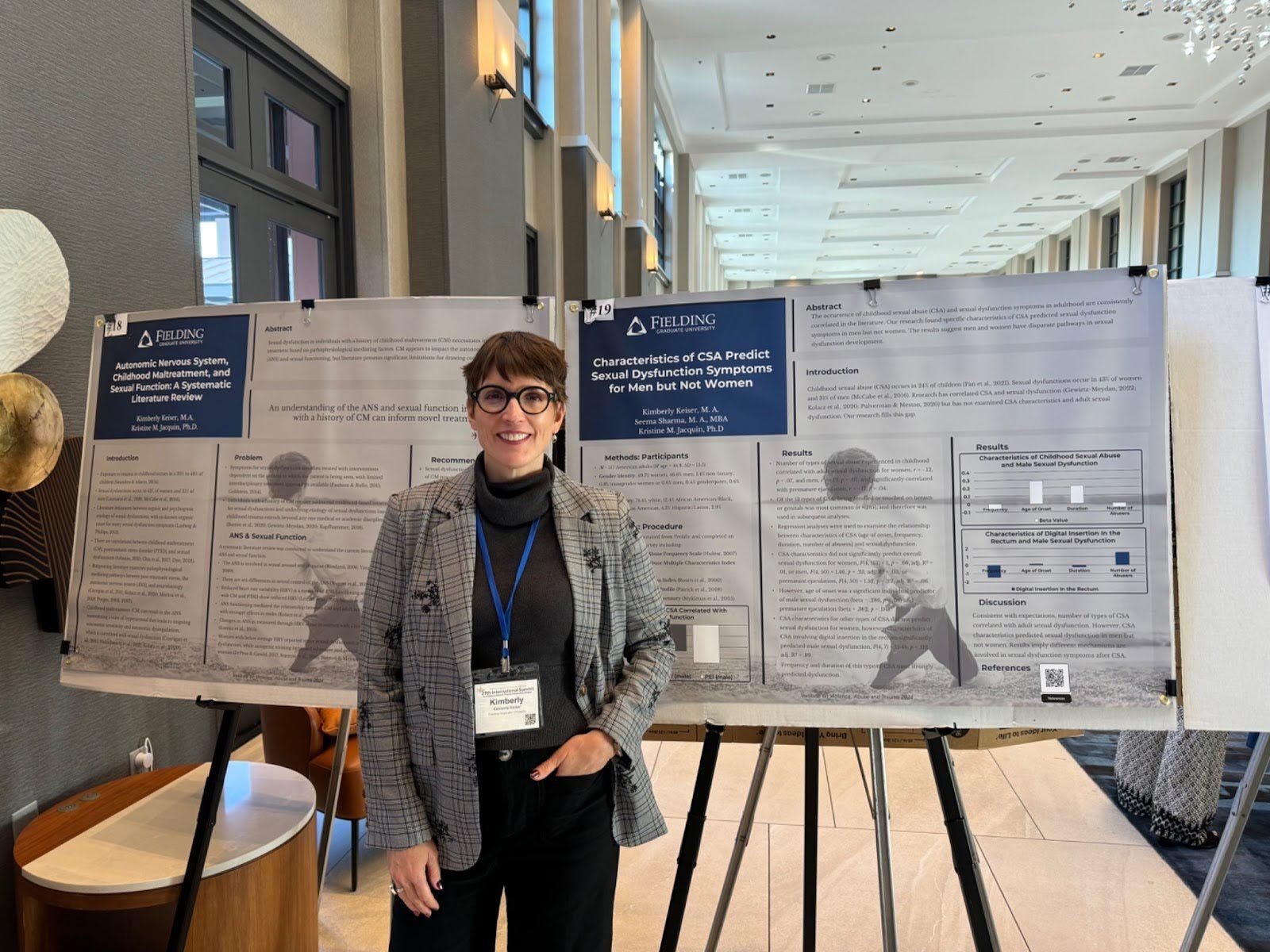Different for Men and Women: Childhood Abuse and Neglect Predict Sexual Dysfunctions
Kimberly presented two posters at the Institute on Violence, Abuse, and Trauma (IVAT) in San Diego, CA on August 25, 2024. The first poster, found on ResearchGate, was a systematic literature review to explore how autonomic nervous system function impacts sexual dysfunction in individuals with a history of childhood abuse and neglect. The second poster, also found on ResearchGate, was original research that found specific characteristics of CSA predicted sexual dysfunction symptoms in men but not women. The results suggest men and women have disparate pathways in sexual dysfunction development.
Autonomic Nervous System, Childhood Maltreatment, and Sexual Function: A Systematic Literature Review
There are correlations between childhood maltreatment, PTSD, and sexual dysfunctions, with recent literature examining pathophysiological mediating pathways between post-traumatic stress and the autonomic nervous system (ANS).
Childhood maltreatment can result in the ANS maintaining a state of hyperarousal that leads to ongoing autonomic sensitivity and autonomic dysregulation, which is correlated with sexual dysfunction.
So, the question is—what are the mechanisms behind childhood maltreatment, post-traumatic stress, and the development of sexual dysfunction symptoms?
Here’s Why We Care:
Symptoms for sexual dysfunctions are often treated with interventions dependent on the context in which the patient is being seen, with limited interdisciplinary treatment approaches available.
For example, if an individual with erectile dysfunction sees a primary care physician or even urologist, treatment will largely consist of medication management with little focus on developmental history. If the same individual sees a psychologist or counselor, greater attention will be focused on developmental and relationship history, with perhaps some focus on sexual developmental history or basic sex therapy interventions. Now, if this individual sees a sex therapist, they will get a variety of treatments that will be considered, depending on the general background and training of the sex therapist—but most interventions will focus on sex therapy techniques to improve sexual functioning. It is highly unlikely this patient will see a provider trained in treating trauma, providing sex therapy, as well as being a medical professional with any training or experience in sexual health or sex therapy.
Understanding the biological underpinnings of sexual function and dysfunction following childhood maltreatment is needed to develop effective treatments.
Individuals with a history of childhood maltreatment require additional evidenced-based treatments for sexual dysfunctions and underlying etiology of sexual dysfunctions based on childhood maltreatment that extends beyond any one medical or academic discipline.
So Where Do We Start?
Heart rate variability is one aspect of ANS function that has been linked to childhood maltreatment, posttraumatic response, and sexual dysfunction.
Kimberly conducted a systematic literature review to understand the current literature on the ANS, heart rate variability, and sexual function given the ANS is involved in sexual arousal and response and is found to be impacted by trauma.
Board Findings:
The literature showed that ANS functioning mediated the relationship between childhood maltreatment and sexual functioning, with stronger effect in males.
Changes in ANS as measured through heart rate variability occur in women with a history of childhood sexual abuse.
Women with below-average heart rate variability reported more sexual dysfunction and more arousal dysfunction, while autogenic training increased subjective and genital arousal in women.
While the literature review yields some initial findings that provide fruitful information supporting this research question, it is lacking and incomplete overall, presenting significant opportunities for developing this knowledge.
Key Message:
What I want to emphasize is that sexual dysfunction in individuals with a history of childhood maltreatment requires interdisciplinary treatment and a neuropsychological understanding of mechanisms underlying symptoms, including differences based on sex.
Recognizing that sexual dysfunctions have unique mediating pathways due to childhood maltreatment is crucial.
Interdisciplinary research and practice are essential for addressing sexual dysfunctions after childhood maltreatment.
Future research focused on understanding the ANS and sexual function in individuals with a history of childhood maltreatment could lead to unique and effective treatments.
Characteristics of CSA Predict Sexual Dysfunction Symptoms for Men but Not Women
Literature has documented the correlation between childhood sexual abuse and symptoms of sexual dysfunction in adulthood. Numerous studies examined childhood sexual abuse as a factor in the development of sexual dysfunction symptoms in both men and women in adulthood.
The question is, however—are the specific characteristics of childhood sexual abuse and their relationship to sexual dysfunction symptoms in adulthood? Additionally, what is the impact of sex differences?
Here’s why we care:
Literature frequently uses terms like childhood sexual abuse without providing clear definitions. There is significant variation in what it means to experience childhood sexual abuse. For some it may involve a single episode incident with touching outside of clothing by an older child, while for others it can include multi-generational incest committed by multiple perpetrators of both sexes within the family that involve repeated and diverse invasive sexual acts. While any form of childhood sexual abuse is unacceptable, the effects of such abuse on a child’s development are not well understood.
In a broader sense, research that has linked childhood sexual abuse to sexual dysfunction but has not examined how the characteristics of childhood sexual abuse influence the development of various symptoms of adult sexual dysfunction. These symptoms vary by sex and their relationship to the characteristics of childhood sexual abuse is unknown.
Childhood sexual abuse is common for both males and females, with a reported occurance of in 24% of children. Sexual dysfunctions occur in 43% of women and 31% of men. What is also common, and what makes this study uniquely positioned in the literature, is that this is the first study examines the characteristics of childhood sexual abuse—specifically age of onset, frequency, duration, and number of abusers—in relation to each symptom of sexual dysfunction across genders.
So where do we start?
517 U.S. adults were recruited through Prolific to complete an anonymous online survey, which included the Childhood Sexual Abuse Frequency Scale and Childhood Sexual Abuse Multiple Characteristics Index —both asked participants about the characteristics of their childhood sexual abuse.
The survey also included the Female Sexual Function Index, the Premature Ejaculation Profile, and the Brief Sexual Function Inventory to examine sexual dysfunction symptoms in both males and females. It should be noted that although gender variation was included in our research, there are currently no validated measures that evaluate sexual dysfunction symptoms beyond the binary.
Broad Findings:
Our study contains several notable findings..
The number of types of sexual abuse experienced in childhood correlates with adult sexual dysfunction in women and is significantly linked with premature ejaculation. These questions addressed a range of sexual activity, spanning “Did someone ever…” “...watch you while you had no clothes on?” or, “expose their private parts for sex reasons?” … to, “put their penis in your vagina?” or, “put any other thing in your vagina or rectum?”
Of the 13 types of childhood sexual abuse, being fondled or touched on the breasts or the genitals was most common and therefore was used in subsequent analyses for this presentation. A future publication will include results for all 13 types of sexual abuse. Regression analyses were used to examine the relationship between being fondled or touched on breasts or genitals and sexual dysfunction.
It was found that the characteristics of childhood sexual abuse did not significantly predict overall sexual dysfunction in either women or men, nor was it an indicator of premature ejaculation. However, age of onset was a significant individual predictor of male sexual dysfunction and premature ejaculation.
Characteristics for other types of childhood sexual abuse did not predict sexual dysfunction for women. However, characteristics of childhood sexual abuse involving digital insertion in the rectum significantly predicted male sexual dysfunction. The frequency and duration of this type of CSA most strongly predicted dysfunction.
Key Message:
The key message I’d like to leave you with is that, consistent with expectations, the number of types of childhood sexual abuse is directly related to adult sexual dysfunction.
Nonetheless, characteristics of childhood sexual abuse predicted sexual dysfunction in men but not women.
Results imply different mechanisms involved in sexual dysfunction symptoms following childhood sexual abuse. This has an important implication in not only understanding how exposure to the characteristics of childhood sexual abuse impacts sexual development and functioning, but also how this differs by sex.
Interested in learning more?
At Kimberly Keiser & Associates, we are committed to delivering clinical services that are based on scientific research. For more information about clinical services, please contact us directly at: (605) 740-6557 or kimberly@kimberlykeiser.com.



